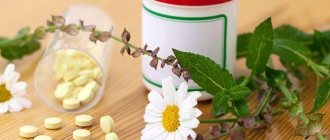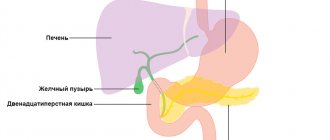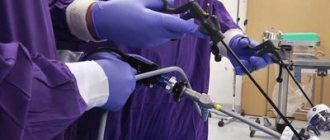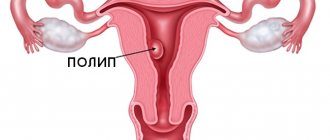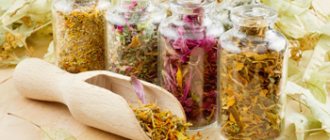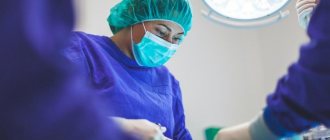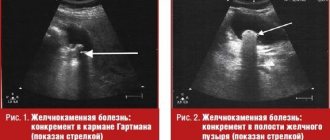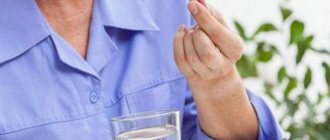The gallbladder is an elastic, pear-shaped organ, hollow inside, it is a reservoir for collecting and storing bile, its capacity is 40-60 ml. About 6% of our country's population suffers from polyps in the gallbladder. Mostly women over 40 are affected. Among those affected, only 20% are men.
If polyps appear on its walls, its capacity decreases, the inflow and outflow of bile is disrupted, which leads to its inflammation and disruption of the gastrointestinal tract as a whole.
Successful treatment of polyps in the gallbladder is only possible if proper nutritional conditions are met. The diseased organ should not be overloaded; timely and regular outflow of bile is necessary at certain intervals.
This diet is not considered strict, since most of the usual foods are not excluded from the diet. And if you approach the issue of cooking with creativity, then restrictions on food and everything will become unnoticeable. In the article we will analyze the basic rules, principles of the diet for polyps in the gallbladder, and give an example menu.
General rules
Gallbladder polyps are benign pathological growths of the mucous membrane of the gallbladder. Polyps can be either single or multiple (polyposis). There are true polyps ( adenomatous polyps and papilloma ) and “pseudopolyps” - cholesterol polyp cholesterol deposits on the mucous membrane and inflammatory polyp - expressed by the proliferation of the epithelium, as a consequence of the inflammatory process.
The clinical picture depends on the size of the polyps and their location. Most patients experience asymptomatic carriage of polyps or experience slight discomfort in the right hypochondrium/upper abdomen or pain after eating a large fatty meal. In cases where the polyp is localized in the neck of the gallbladder and its large size, the symptoms are more pronounced and manifest as periodic intense pain in the right hypochondrium. Polyps in the gallbladder are more often diagnosed against the background of biliary dyskinesia , chronic cholecystitis , and cholelithiasis . Both with single polyps and with gallbladder polyposis, the main danger lies in the high frequency (from 10 to 33%) of their malignancy (degeneration into a malignant tumor).
Treatment of polyps is determined by its size and growth dynamics:
- Polyps measuring 10 mm or more, especially in the presence of stones and in cases of impaired bile outflow, are subject to mandatory surgical removal ( cholicystectomy ).
- If the polyp is less than 10 mm, monitor it over time (ultrasound once every three months). With an increase in size, as well as the appearance of new polyps, surgical removal is necessary.
If the size of the polyps is small and the symptoms are mild, the patient is recommended to switch to a diet. The diet for polyps in the gall bladder is based on the classical treatment Table No. 5 according to Pevzner, the purpose of which is to ensure sparing of the liver and gall bladder, normalization of fat/cholesterol metabolism, as well as the process of bile outflow while providing the patient’s body with the physiological norm of all food macro/micronutrients.
The calorie content of the daily diet varies between 2800-2850 kcal (90 g protein, 350-400 g carbohydrates and 75-80 g fat). The diet provides for limiting the consumption of table salt to 7-10 g/day, free liquid - at the level of 1.5 liters. To prepare dishes, gentle cooking methods are used - boiling, stewing, baking. Cooking food by frying is not permitted.
The diet limits all foods and dishes with a high content of extractive substances, purine bases and essential oils - concentrated broths with meat, fish, dried, fried and smoked foods, fatty meat, fatty cottage cheese, egg yolks, animal liver, brains, baker's yeast, sprats, herring, sardines, tuna, salmon caviar, sausages, lard, dried porcini mushrooms, mussels, shrimp, canned food, cooking oils, spices, salted, pickled products, horseradish, mustard, all types of radishes, pickled vegetables, turnips, radishes, green onions, garlic.
Also excluded are products that promote fermentation/rotting processes (white cabbage, legumes, millet, rye bread), sour fruits/berries (cranberries, citrus fruits, sour apples and plums), as well as confectionery with cream, coffee, chocolate, ice cream, cocoa, carbonated drinks, alcohol.
The diet should contain dietary varieties of red meat (beef, veal) and chicken, turkey, and rabbit. Fish can be consumed only low-fat and infrequently (up to 3 times a week). It is important to have in your diet a sufficient amount of foods containing pectins , fiber and lipotropic compounds - a variety of vegetables and fruits, cereals.
The vegetable list of products is varied: almost all consumed vegetables (with the exception of prohibited ones) are boiled/baked, as well as sauerkraut. Fruits and berries can be consumed in any form. In addition to fiber, products containing polyunsaturated fatty acids, lecithin and phytosterols , which are found in sufficient quantities in flaxseed, corn, olive, sunflower and other vegetable oils, have a pronounced lipotropic effect.
The diet may include crackers/stale wheat bread, protein steamed omelettes, soups with boiled cereals/vegetarian soups with vegetables, low-fat/low-fat cottage cheese, diluted milk, fermented milk products, butter in ready-made dishes (up to 20 g/day), porridge from rice, buckwheat, oatmeal, rolled oats, cooked in water, ripe fruits (baked and pureed raw), jelly, honey, marmalade, sugar, jelly, jam, marshmallows. Useful drinks include rosehip infusion, tea with lemon and sugar, sweet juices, weak coffee, and green tea.
Diet for polyps in the gallbladder after their removal, regardless of the type of surgery (traditional cholecystectomy or laparoscopy ) is an essential component of the treatment and recovery process. The most important period is the first days after surgery. Within 4-6 hours after removal of polyps, drinking any liquid is prohibited - you can only moisten the patient’s lips with water, and after 5-6 hours you are allowed to rinse your mouth with herbal infusions.
In the period 12-24 hours after surgery, you can give the patient 1-2 sips of drink every 10-20 minutes with a total volume of up to 500 ml in the form of still table water. On the second day after the operation, the diet is expanded to include unsweetened tea, low-fat kefir, jelly in 250 ml portions at intervals of 1 time/3 hours up to 1.5 l/day.
On the next day, it is allowed to take pureed soups with vegetable broth, semi-liquid mashed potatoes, steamed egg white omelet, boiled grated lean fish, fruit jelly and low-fat sour cream. Portions 150-200 g, 7-8 times a day. As a liquid, tea with sugar, apple/pumpkin juice. From the 5th day it is allowed to eat dry wheat bread (up to 100 g), biscuits, and on the 6-7th day - pureed oatmeal/buckwheat porridge, vegetable puree, chopped boiled fish/meat, low-fat fermented milk products, pureed cottage cheese.
From 8-9 days the patient is transferred to diets No. 5a, 5b, depending on the patient’s condition and the severity of symptoms. A characteristic feature of these diets is their reduced calorie content of the daily diet to the level of 1600-1700 kcal (55-65 g of protein, 250-300 g of carbohydrates and 40-50 g of fat).
All dishes are prepared pureed with the addition of unsalted butter: slimy cereal soups, pureed steamed meat, boiled fish, thoroughly pureed porridge of a semi-liquid consistency with the inclusion of low-fat milk, jelly, dried bread, wheat/crackers, jelly/jelly, low-fat cottage cheese. Meals after removal of polyps are fractional, at least 5 times, portions no more than 200 g, without salt.
The amount of free fluid is about 2.5 l/day. In the absence of complications and normal health, the patient is transferred to the basic Diet No. 5 , which is recommended to be on for 3-6 months.
Diet for polyps in the gallbladder
Knowing the prohibited and permitted foods, you can easily select your diet. The patient’s menu should be as gentle as possible and conducive to a quick recovery. If the patient follows the doctor’s instructions, the flow of bile in the organ will improve, the swelling symptom and spasms will disappear.
Diet menu
A convalescent day consists of five meals. Below is a sample menu.
The patient's first breakfast consists of oatmeal, which is supplemented with fresh berries, and cottage cheese casserole. For dessert, prepare a banana smoothie or rice pudding. You can wash everything down with lightly brewed tea and low-fat milk.
For second breakfast, eat a light vegetable salad. An alternative could be baked apple or pear.
For lunch, they prepare vegetable soup, cooked in water, not in broth. Supplement the soup with a steamed cutlet. It can be replaced with chicken fillet. Instead of tea, make compote from dried fruits.
The afternoon snack is like a second breakfast. It consists of a salad made from vegetables or fruits. You can make jelly or replace it with dried fruit compote.
For dinner, it is best to eat boiled or chopped vegetables. Finish your dinner with any dairy product.
Recipes for individual dishes
- Vegetable soup with oatmeal. To prepare the soup you need to take a couple of potatoes and carrots. Since it is prepared without frying, chopped carrots along with potatoes are thrown directly into the soup. 5 minutes before the end, add a couple of spoons of oatmeal. Season the dish with a little salt, sunflower oil, and fresh herbs.
- Carrot cream soup. This soup is prepared with vegetable broth. To prepare it you need half a liter. Place two finely chopped carrots, salt and a small piece of butter into boiling water. Make cream soup from the soup using a blender. Complete the dish with croutons.
- Cottage cheese paste. To prepare pate, you should mix a hundred grams of low-fat cottage cheese with sugar and a spoonful of sour cream. This option is also suitable in salted form. To do this, instead of sugar, add salt with finely chopped fresh dill.
- Egg white omelette. For this dish, you need to separate the whites from the yolks of three eggs. Mix the resulting three whites with a whisk with a few tablespoons of milk, add salt. Prepare an omelet using a double boiler. If not available, fry in a frying pan with a small piece of butter.
Authorized Products
The diet for polyps in the gallbladder in the preoperative period and during the recovery stage after their removal includes dried wheat bread/white crackers, and, if tolerated, rye bread or made from peeled flour. Soups are prepared in weak vegetable broths with the addition of vegetables, cereals and noodles, with the addition of unsalted butter or low-fat sour cream without frying.
To prepare second courses, it is recommended to use veal, lean beef, rabbit meat, poultry (chicken, turkey) boiled/baked, chopped or in pieces. The diet can include low-fat white river/sea fish with vegetables and boiled seafood. Vegetables are baked, boiled or steamed and served in the form of salads, vinaigrettes, caviar, seasoned with vegetable oils or sour cream.
Chicken eggs - exclusively in the form of steam omelettes or boiled soft-boiled, preferably without yolks. The diet should include low-fat fermented milk products: kefir, acidophilus, yogurt, low-fat cottage cheese (in the form of casseroles and natural). Milk may only be used as an additive to dishes and tea. Sour cream and butter - as a seasoning for ready-made dishes.
Cereals should be well boiled. For spices, you can use garden herbs and add cinnamon to sweet dishes. As a dessert, you can include non-acidic fruits/berries in any form, marmalade, jam, honey in your diet. It is better to partially replace sugar with xylitol. Consume free liquid in sufficient quantities, mainly in the form of tea/coffee with milk, rosehip infusion, vegetable/fruit juices, non-carbonated mineral water.
Table of permitted products
| Proteins, g | Fats, g | Carbohydrates, g | Calories, kcal | |
Vegetables and greens | ||||
| eggplant | 1,2 | 0,1 | 4,5 | 24 |
| zucchini | 0,6 | 0,3 | 4,6 | 24 |
| cabbage | 1,8 | 0,1 | 4,7 | 27 |
| broccoli | 3,0 | 0,4 | 5,2 | 28 |
| carrot | 1,3 | 0,1 | 6,9 | 32 |
| cucumbers | 0,8 | 0,1 | 2,8 | 15 |
| salad pepper | 1,3 | 0,0 | 5,3 | 27 |
| parsley | 3,7 | 0,4 | 7,6 | 47 |
| iceberg lettuce | 0,9 | 0,1 | 1,8 | 14 |
| tomatoes | 0,6 | 0,2 | 4,2 | 20 |
| pumpkin | 1,3 | 0,3 | 7,7 | 28 |
| dill | 2,5 | 0,5 | 6,3 | 38 |
Fruits | ||||
| bananas | 1,5 | 0,2 | 21,8 | 95 |
| apples | 0,4 | 0,4 | 9,8 | 47 |
Nuts and dried fruits | ||||
| raisin | 2,9 | 0,6 | 66,0 | 264 |
| dried figs | 3,1 | 0,8 | 57,9 | 257 |
| dried apricots | 5,2 | 0,3 | 51,0 | 215 |
| dried apricots | 5,0 | 0,4 | 50,6 | 213 |
| prunes | 2,3 | 0,7 | 57,5 | 231 |
Cereals and porridges | ||||
| buckwheat | 4,5 | 2,3 | 25,0 | 132 |
| oatmeal | 3,2 | 4,1 | 14,2 | 102 |
| pearl barley porridge | 3,1 | 0,4 | 22,2 | 109 |
| rice | 6,7 | 0,7 | 78,9 | 344 |
Flour and pasta | ||||
| pasta | 10,4 | 1,1 | 69,7 | 337 |
| buckwheat noodles | 14,7 | 0,9 | 70,5 | 348 |
Bakery products | ||||
| bran bread | 7,5 | 1,3 | 45,2 | 227 |
| whole grain bread | 10,1 | 2,3 | 57,1 | 295 |
Confectionery | ||||
| jam | 0,3 | 0,2 | 63,0 | 263 |
| jelly | 2,7 | 0,0 | 17,9 | 79 |
| marshmallows | 0,8 | 0,0 | 78,5 | 304 |
| milk candies | 2,7 | 4,3 | 82,3 | 364 |
| fondant candies | 2,2 | 4,6 | 83,6 | 369 |
| fruit and berry marmalade | 0,4 | 0,0 | 76,6 | 293 |
| paste | 0,5 | 0,0 | 80,8 | 310 |
| Maria cookies | 8,7 | 8,8 | 70,9 | 400 |
Raw materials and seasonings | ||||
| honey | 0,8 | 0,0 | 81,5 | 329 |
| sugar | 0,0 | 0,0 | 99,7 | 398 |
Dairy | ||||
| kefir 1.5% | 3,3 | 1,5 | 3,6 | 41 |
| Ryazhenka | 2,8 | 4,0 | 4,2 | 67 |
Cheeses and cottage cheese | ||||
| cottage cheese | 17,2 | 5,0 | 1,8 | 121 |
| cottage cheese 1% | 16,3 | 1,0 | 1,3 | 79 |
Meat products | ||||
| beef | 18,9 | 19,4 | 0,0 | 187 |
| rabbit | 21,0 | 8,0 | 0,0 | 156 |
Sausages | ||||
| boiled diet sausage | 12,1 | 13,5 | 0,0 | 170 |
| boiled milk sausage | 11,7 | 22,8 | 0,0 | 252 |
| milk sausages | 12,3 | 25,3 | 0,0 | 277 |
Bird | ||||
| boiled chicken breast | 29,8 | 1,8 | 0,5 | 137 |
| boiled chicken drumstick | 27,0 | 5,6 | 0,0 | 158 |
| boiled turkey fillet | 25,0 | 1,0 | — | 130 |
Eggs | ||||
| soft-boiled chicken eggs | 12,8 | 11,6 | 0,8 | 159 |
Fish and seafood | ||||
| flounder | 16,5 | 1,8 | 0,0 | 83 |
| pollock | 15,9 | 0,9 | 0,0 | 72 |
| cod | 17,7 | 0,7 | — | 78 |
| hake | 16,6 | 2,2 | 0,0 | 86 |
Oils and fats | ||||
| butter | 0,5 | 82,5 | 0,8 | 748 |
| olive oil | 0,0 | 99,8 | 0,0 | 898 |
| sunflower oil | 0,0 | 99,9 | 0,0 | 899 |
Non-alcoholic drinks | ||||
| water | 0,0 | 0,0 | 0,0 | — |
| mineral water | 0,0 | 0,0 | 0,0 | — |
| green tea | 0,0 | 0,0 | 0,0 | — |
Juices and compotes | ||||
| apricot juice | 0,9 | 0,1 | 9,0 | 38 |
| carrot juice | 1,1 | 0,1 | 6,4 | 28 |
| peach juice | 0,9 | 0,1 | 9,5 | 40 |
| plum juice | 0,8 | 0,0 | 9,6 | 39 |
| tomato juice | 1,1 | 0,2 | 3,8 | 21 |
| pumpkin juice | 0,0 | 0,0 | 9,0 | 38 |
| rose hip juice | 0,1 | 0,0 | 17,6 | 70 |
| * data is per 100 g of product | ||||
Rules of the new diet
Growths can be of different shapes and types. Diet will help get rid of them
The most rational for this case is diet No. 5. There are several options with more or less calories, but the general principles remain the same:
- Food should be taken at approximately the same time 5-6 times a day.
- It should not be very hot or too cold, or deep-fried - fried foods taste good, but they require large amounts of bile to digest, which puts strain on the liver and gallbladder.
- A deep fryer or frying pan should be replaced with an oven; dishes cooked in it do not irritate the digestive organs; you should also not forget about steaming food, regular boiling and stewing.
Authorized Products
List of acceptable foods:
- All types of bakery products, provided that they are not freshly baked.
- All types of noodles and pasta.
- Cereals.
- Milk and dairy products.
- Soft-boiled eggs and steamed omelettes, no more than 3 per day.
- Low-fat meats, chicken, turkey, rabbit, dietary varieties of sausages and frankfurters.
- Not oily fish.
- Vegetables.
- Fruits.
- Vegetable oil.
- Tea, coffee with milk, jelly, compotes, vegetable and fruit juices, still mineral water.
- Sweets, honey
- Dill and parsley.
Prohibited
The following foods should not be consumed:
- Pastries, cakes and pastries.
- Fatty fish, smoked meats and canned fish.
- Fatty meats, lard, smoked meats.
- Duck and goose.
- All legumes.
- Spicy vegetables: celery, parsnips, parsley roots, cilantro, hot peppers.
- Radish, radish, sorrel, onion, garlic.
- Black coffee, cocoa, all types of alcoholic drinks.
- Chocolate and chocolate candies.
Place a taboo on the specified food
Fully or partially limited products
A diet for polyps in the gall bladder involves excluding from the diet foods and dishes containing large amounts of extractives, purine bases and essential oils that stimulate the secretion of the gastrointestinal tract - concentrated broths of meat, fish, smoked, dried or fried foods, all types of fatty meat , egg yolks, waterfowl meat, sausages, offal (animal liver, kidneys, brains), salmon caviar, cooking oils, baker's yeast, sardines, sprats, herring, tuna, bacon, lard, mushrooms, horseradish, mustard, seafood , canned food, spices, salted, pickled foods, all types of radishes, pickled vegetables, turnips, garlic, radishes, onions, sorrel, spinach.
Excluded from the diet are fried and hard-boiled chicken eggs, fresh bread, puff pastry, fried pies, pastries, cakes, baked goods, whole fat milk and cream, all legumes and vegetables containing coarse fiber - radishes, radishes, turnips.
Hot seasonings and spices, margarine and mayonnaise are not allowed. Strong black coffee, cocoa, Pepsi, cola, chocolate, and alcohol-containing drinks are excluded from the diet.
Table of prohibited products
| Proteins, g | Fats, g | Carbohydrates, g | Calories, kcal | |
Vegetables and greens | ||||
| canned vegetables | 1,5 | 0,2 | 5,5 | 30 |
| swede | 1,2 | 0,1 | 7,7 | 37 |
| peas | 6,0 | 0,0 | 9,0 | 60 |
| bulb onions | 1,4 | 0,0 | 10,4 | 41 |
| chickpeas | 19,0 | 6,0 | 61,0 | 364 |
| radish | 1,2 | 0,1 | 3,4 | 19 |
| white radish | 1,4 | 0,0 | 4,1 | 21 |
| beans | 7,8 | 0,5 | 21,5 | 123 |
| horseradish | 3,2 | 0,4 | 10,5 | 56 |
| spinach | 2,9 | 0,3 | 2,0 | 22 |
| sorrel | 1,5 | 0,3 | 2,9 | 19 |
Berries | ||||
| grape | 0,6 | 0,2 | 16,8 | 65 |
Mushrooms | ||||
| mushrooms | 3,5 | 2,0 | 2,5 | 30 |
| marinated mushrooms | 2,2 | 0,4 | 0,0 | 20 |
Nuts and dried fruits | ||||
| nuts | 15,0 | 40,0 | 20,0 | 500 |
| almond | 18,6 | 57,7 | 16,2 | 645 |
Snacks | ||||
| potato chips | 5,5 | 30,0 | 53,0 | 520 |
Flour and pasta | ||||
| vareniki | 7,6 | 2,3 | 18,7 | 155 |
| dumplings | 11,9 | 12,4 | 29,0 | 275 |
Bakery products | ||||
| buns | 7,9 | 9,4 | 55,5 | 339 |
Confectionery | ||||
| pastry cream | 0,2 | 26,0 | 16,5 | 300 |
| shortbread dough | 6,5 | 21,6 | 49,9 | 403 |
Ice cream | ||||
| ice cream | 3,7 | 6,9 | 22,1 | 189 |
Chocolate | ||||
| chocolate | 5,4 | 35,3 | 56,5 | 544 |
Raw materials and seasonings | ||||
| mustard | 5,7 | 6,4 | 22,0 | 162 |
| mayonnaise | 2,4 | 67,0 | 3,9 | 627 |
Dairy | ||||
| milk 4.5% | 3,1 | 4,5 | 4,7 | 72 |
| cream 35% (fat) | 2,5 | 35,0 | 3,0 | 337 |
| whipped cream | 3,2 | 22,2 | 12,5 | 257 |
Cheeses and cottage cheese | ||||
| gouda cheese | 25,0 | 27,0 | 2,0 | 356 |
| parmesan cheese | 33,0 | 28,0 | 0,0 | 392 |
Meat products | ||||
| fatty pork | 11,4 | 49,3 | 0,0 | 489 |
| salo | 2,4 | 89,0 | 0,0 | 797 |
| bacon | 23,0 | 45,0 | 0,0 | 500 |
Sausages | ||||
| smoked sausage | 9,9 | 63,2 | 0,3 | 608 |
Bird | ||||
| smoked chicken | 27,5 | 8,2 | 0,0 | 184 |
| duck | 16,5 | 61,2 | 0,0 | 346 |
| smoked duck | 19,0 | 28,4 | 0,0 | 337 |
| goose | 16,1 | 33,3 | 0,0 | 364 |
Eggs | ||||
| hard-boiled chicken eggs | 12,9 | 11,6 | 0,8 | 160 |
Fish and seafood | ||||
| smoked fish | 26,8 | 9,9 | 0,0 | 196 |
| black caviar | 28,0 | 9,7 | 0,0 | 203 |
| salmon caviar granular | 32,0 | 15,0 | 0,0 | 263 |
| salmon | 19,8 | 6,3 | 0,0 | 142 |
| canned fish | 17,5 | 2,0 | 0,0 | 88 |
| salmon | 21,6 | 6,0 | — | 140 |
| trout | 19,2 | 2,1 | — | 97 |
Oils and fats | ||||
| cooking fat | 0,0 | 99,7 | 0,0 | 897 |
Alcoholic drinks | ||||
| white dessert wine 16% | 0,5 | 0,0 | 16,0 | 153 |
| dry red wine | 0,2 | 0,0 | 0,3 | 68 |
| vodka | 0,0 | 0,0 | 0,1 | 235 |
| beer | 0,3 | 0,0 | 4,6 | 42 |
Non-alcoholic drinks | ||||
| soda water | 0,0 | 0,0 | 0,0 | — |
| cola | 0,0 | 0,0 | 10,4 | 42 |
| instant coffee dry | 15,0 | 3,5 | 0,0 | 94 |
| sprite | 0,1 | 0,0 | 7,0 | 29 |
| * data is per 100 g of product | ||||
Menu creation
As we said above, a diet for polyps cannot be called strict - the main part of the usual foods is not excluded from the diet, and with skillful preparation, the restrictions will not be noticeable. When preparing a diet for each day, it is necessary to take into account the patient’s taste preferences. Most often, we ourselves turn proper nutrition into a set of tasteless dishes and call them a diet, introducing a negative meaning into this word.
If the patient is recommended to lose weight and does not engage in heavy physical labor, the body will need no more than 1800-2500 calories per day, and with increasing loads - up to 2800-3500 . At the same time, it is not necessary to eat much more food, it is enough to choose foods that are higher in calories; the total volume of food eaten and drunk per day should be a maximum of 3.5-4 kilograms.
With a low-calorie diet, the patient needs: 85-90 g of protein, 90-100 g of fat, 400-450 grams of carbohydrates (85-90 g of sugar), water is taken randomly, about 2 liters, salt - 8-10 g.
Creating an individual diet is not at all difficult. Each food package has nutritional information, and many cookbooks contain a calorie table for prepared meals.
In the following table we have collected the following information about the most popular products:
| Name | Calorie content per 100 g, cal. |
| Milk 2.5% | 52 |
| Milk 3.2% | 58 |
| Kefir 3.2% | 56 |
| Chicken's meat | 167 |
| Turkey meat | 197 |
| Rabbit meat | 199 |
| Chicken meat | 156 |
| Mutton | 203 |
| Veal | 90 |
| Beef | 187 |
| Pork | 480 |
| Beef liver | 98 |
| Pork liver | 108 |
| Chicken eggs | 157 |
| Quail eggs | 168 |
| Potato | 60 |
| White cabbage | 23 |
| Cauliflower | 18 |
| Broccoli | 34 |
| Zucchini | 24 |
| Eggplant | 25 |
| Carrot | 33 |
| Beet | 40 |
| Onions (can be used stewed or boiled) | 43 |
| cucumbers | 15 |
| Tomatoes | 20 |
| Apples | 45 |
| Bananas | 90 |
| Tangerines | 41 |
| Oranges | 45 |
| Strawberry | 38 |
| Pears | 42 |
Example
The menu for every day should not only be sufficiently high in calories, varied, and consisting of delicious dishes. Its composition depends on the patient’s taste preferences. Breakfast may include the first and second courses of a regular lunch; if this has become a habit, there is no need to make changes. Many people do not like dairy products and cheeses with low fat content - there is no need to limit yourself, you need to reduce the portion.
Sample menu for the day:
- breakfast - milk soup or porridge with butter and sugar, sandwich with tea;
- second breakfast - vegetable or fruit juice with buns;
- lunch - cabbage soup in chicken broth, boiled chicken with rice, cottage cheese casserole with sour cream, compote;
- afternoon snack - milk with cookies;
- dinner - vegetable stew, baked or steamed cutlets, jelly;
- before bed - kefir.
Advantages and disadvantages
| pros | Minuses |
|
|
Allowed and prohibited products for kidney cysts
The diet for kidney cysts includes permitted foods:
- Fresh vegetables and fruits;
- Vegetable soups without adding fish and meat broths;
- Day-old bread (which has no protein);
- Dairy products;
- A small amount of lean meat and fish;
- Greenery;
- Weak green tea;
- Unsalted and low-fat cheese and cottage cheese.
The following foods are excluded from the diet:
- White bread;
- Alcohol;
- Rich meat and fish broths;
- Canned food;
- Chocolate;
- Canned food;
- Salty and fatty cheeses;
- Beans;
- Carbonated drinks.
The cooks at the Yusupov Hospital prepare dishes from high-quality products for patients with kidney cysts, providing balanced nutrition rich in vitamins and minerals.
Reviews and results
Reviews from the overwhelming number of patients who have polyps in the gallbladder and have undergone surgery to remove them indicate the extreme importance and effectiveness of therapeutic nutrition. The diet is easily tolerated, however, the inconvenience can be considered the need for individual preparation, as well as the skills and knowledge of preparing dietary dishes and the time investment.
- “... During an ultrasound examination, several polyps measuring 6-9 mm were found in the gallbladder. Observation was recommended. Followed up for 2 years. At the last examination, the size increased to 1-1.2 cm and several new small polyps appeared. They offered to undergo surgery. After my gallbladder was removed, I was on a diet for almost 5 months. It's good that I can cook myself. Six months later, everything returned to normal, but I still continue to follow a more extensive diet”;
- “... After cholecystectomy for 2 large polyps, I have been following Diet No. 5 for almost 1.5 years. I’m already accustomed to the restrictions of fatty, fried, smoked and spicy foods. I feel good, and I’ve also lost weight. Sometimes on holidays I make small mistakes in my diet, but then I go back to the diet again. The only disadvantage can be considered to be the difficulty of preparation, since I often work until late and need to take ready-made food with me. True, after I purchased a good professional steamer, the cooking process accelerated and became easier.”
Nutrition for kidney cysts
For kidney cysts, regardless of the type of treatment and stage of the disease, the dietary table according to Pevzner No. 7 is used. The diet for kidney cysts is individual. The cooks at the Yusupov Hospital take into account the culinary preferences of patients when preparing dishes.
Fatty, fried, smoked foods and pickles are completely excluded from the patient's diet. Limit fluid and salt intake, which can increase daily diuresis. Patients are advised to refrain from drinking alcohol, hot spices and sweet carbonated water. Due to the risk of complications, all patients with kidney cysts must avoid hypothermia and heavy physical labor.
